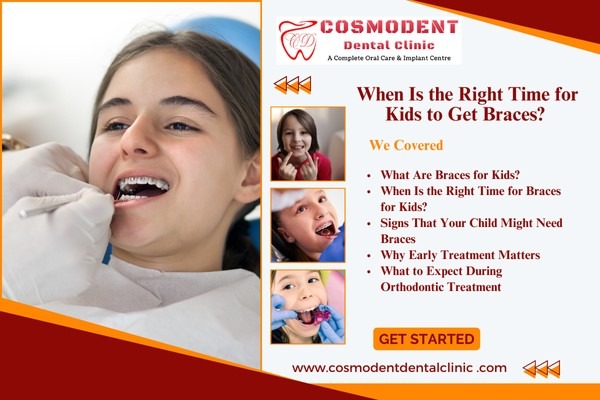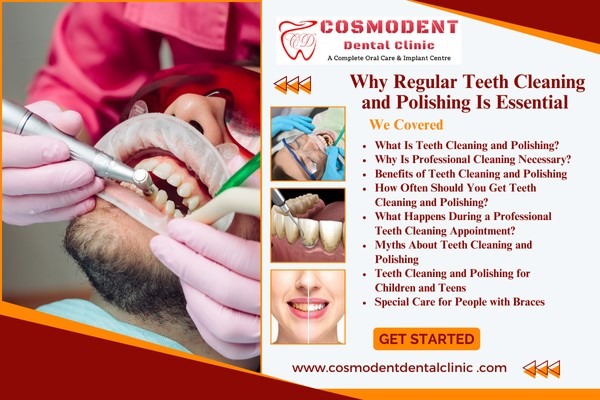As a parents, you want your child to have a healthy smile that lives all your life. But when it comes to braces, many parents wonder: When does children have the right time to get them? If you are hesitant if it is time for children to have braces, do not worry. We are here to guide you through this process so you can make the best decision for your child.
What Are Braces for Kids?

Braces is a dental treatment used to correct the teeth and to fix biting problems. They contain small metal or ceramic brackets associated with teeth, which are attached to the wires. Over time, these components gradually move teeth to a better position.
Braces help with a variety of issues, such as:
- Crooked or misaligned teeth
- Overbites or underbites
- Gaps between teeth
- Teeth that are crowded or overlapping
- Jaw alignment problems
While braces improve your child’s smile, they also help with chewing, speaking, and preventing future dental problems.
When Is the Right Time for Braces for Kids?
Determining the best time to get braces for kids depends on the child’s growth and development. Each child is different, but there are general guidelines that can help.

- The Right Age for an Evaluation
The American Association of Orthodontics recommends that children have their first orthodontic evaluation to 7 years. You may be wondered why it is necessary if your child still has children’s teeth. The reason for this is that even at an early age, a conservative can see possible problems that can later affect the child’s smile.
Achieving an initial assessment does not mean that your child will require immediate harnesses, but this allows the orthodontist to take steps to quickly present the problems and prevent them from becoming major problems.
- The Ideal Time for Braces for Kids
Most kids get braces for kids when they’re between 9 and 14 years old. At this age, the permanent teeth usually come, and their jaw is stable enough to work effectively for braces. It is also easy for children to understand the importance of their Braces care during this period.
If your child’s teeth or bite need correction, the orthodontist may recommend braces. The timing is ideal because the bones in the jaw are still a bit flexible, making it easier for braces to do their job.
- Early Treatment vs. Later Treatment
In some cases, initial treatment (step 1) may be necessary to solve certain problems, such as severe bite problems or overcrowded teeth. This treatment usually occurs between 7 and 10 years and helps to correct the development of the jaw. This can prevent more serious problems from developing and reducing the need for more extensive treatment later.
However, phase 2 (complete treatment with seals) usually occurs after all permanent teeth arrive, usually between 11 and 14 years. This stage focuses on straightening your teeth and fixing any remaining biting problems.
Signs That Your Child Might Need Braces
So, how can you tell if your child might need braces? Here are some common signs to look for:
- Crooked or misaligned teeth: If your child’s teeth are crooked, overlapped, or not aligned properly, braces might be needed to straighten them out.
- Overbite or underbite: If your child’s upper teeth protrude too far over the lower teeth (overbite) or the lower teeth extend past the upper teeth (underbite), braces can help correct the bite.
- Difficulty chewing or speaking: If your child has trouble chewing food or pronouncing certain sounds, misalignment could be to blame.
- Thumb-sucking or pacifier use: Prolonged thumb-sucking or pacifier use can cause teeth and jaw issues that may require braces.
- Gaps between teeth: Large gaps between teeth can affect appearance and sometimes cause speech issues.
- Crowded teeth: If there isn’t enough room for all of your child’s teeth, they may become crowded and misaligned.
If any of these signs sound familiar, it’s a good idea to visit an orthodontist for a consultation.
Why Early Treatment Matters
Getting braces at the right time has many benefits. Here’s why early treatment can be so important:
- Prevent Future Problems
By catching dental problems quickly, orthodontist can prevent more serious problems than developing later. For example, initial treatment can help cure a bite problem or prevent teeth from causing tooth damage or gum disease.
- Helps with Jaw Growth
When a child’s jaw is still developing, braces can guide it into a better position. This can help prevent jaw issues later and improve the overall alignment of the teeth.
- Shorter Treatment Time
In some cases, early intervention can help reduce the length of time a child needs to wear braces later on. Correcting issues early can make full treatment faster and easier.
- Boosts Self-Confidence
A beautiful smile is important, and getting braces can help your child feel better about their appearance. Straightening their teeth early can give them a confidence boost and help them avoid teasing or self-consciousness during their teen years.
What to Expect During Orthodontic Treatment
If your child is ready for braces for kids, here’s what you can expect during the treatment process:
- Initial Consultation: The orthodontist will examine your child’s teeth and jaw, take X-rays, and discuss treatment options. This is when you’ll learn if braces are needed and the best time to start.
- Braces Placement: Once the decision is made to move forward, the orthodontist will attach the brackets to your child’s teeth and connect them with wires. This process may take a couple of hours.
- Follow-Up Appointments: Your child will need to visit the orthodontist every 4-6 weeks for adjustments. This is when the orthodontist will tighten the wires and make sure everything is moving in the right direction.
- Post-Braces Care: After the braces are removed, your child will likely need to wear a retainer to keep their teeth in their new position. This is an essential step to ensure that the teeth don’t shift back.
Conclusion
The right time for braces for depends on your child’s individual needs. Although it is useful to get evaluation around 7 years, most children start treatment between 9 and 14 years. Initial intervention can help prevent more serious problems and make future treatment easier and shorter.
If you notice signs such as crooked teeth, biting problems or difficulty chewing, it is a good idea to book an appointment with our orthodontist. With proper treatment, your child can have a healthy smile that lasts a lifetime.








